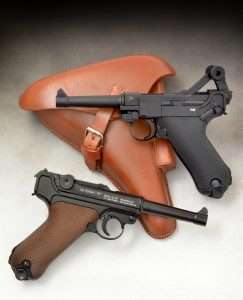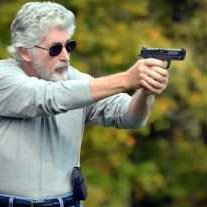Luger vs. Luger – Evaluating the Umarex and Gletcher P.08 Models

The Luger is one of the most “available” military handguns in the world and their values can range from around $1,800 to $10,000 and up, depending upon the model, year of manufacture, the manufacturer, and of course, condition. The average price for a 95 percent condition Code 42 or byf Mauser-produced P.08 model is around the $2,000 to $3,000 mark [1], which makes the Umarex Legends .177 caliber Mauser Parabellum P.08 model a heck of a buy since it has all of the essential operating features and factory markings, right down to the number 42 stamped at the back of the toggle. This was the Mauser GmbH manufacturer’s code for military contract guns built from 1934 to 1940. After 1940 the code was changed to byf.
During WWII the manufacturer’s identification code was required on all P.08 models because it was built by several different armsmakers, and the military needed a quick means of distinguishing manufacturers. Interestingly, although Walther never manufactured the Luger P.08, during WWII, Mauser also built P.38s and these are also stamped with the manufacturer’s code byf, just like the P.08 Lugers.

On the Parabellum P.08 air pistol, Umarex has used both the Mauser manufacture’s number 42 and the letters ac; which was the manufacturer’s code for Walther. This was used on Walther P.38 pistols beginning in 1941 (ac 41, ac 42, etc.). Luger P.08 parts were additionally stamped with two digits from the gun’s serial number and the Umarex models use the number 15 on the disassembly lever, left sideplate (trigger plate), and safety bar, for an even more authentic look.

The left side of the receiver is also properly stamped GESICHERT (German for secured). This is seen when the safety lever is set to the S position. When the safety is moved to F the word is covered by the lever and a red dot revealed, thus the Umarex operates exactly the same way as its cartridge-firing counterpart. They also subtly mark the guns “P.08” on the left rear of the frame and even more discretely put the caliber markings, proof mark and serial number on the underside of the barrel to be less obtrusive. The only big visual distraction is the safety warning written on the right side of the air pistol’s barrel lug.

Another important feature is the toggle link design on the Umarex P.08, which is fully functional and locks back after the last round is fired. The Umarex also disassembles like a 9mm P.08 Parabellum by removing the magazine, pulling the toggle back slightly, rotating the disassembly lever downward, lifting the trigger plate and sliding it out of its notched recess, and then pulling the entire barrel and receiver off the frame. Thus in overall operation, the .177 caliber model is the same as the cartridge firing P.08 Luger except for using CO2 and steel BBs. And if you are wondering about the black plastic grips (as opposed to the more accurate-looking wood grained plastic grips on the Gletcher P.08), black grips are also correct for a late model Mauser-built P.08. In the last two years of wartime production (military manufacturing of the P.08 was phased out beginning in 1942), Mauser-built Lugers were fitted with new black Bakelite (plastic) grips instead of wood, in order to reduce manufacturing costs. This same material was also used for the magazine base. These distinctive Mauser P.08 models with black grips are referred to today as the “Black Widow” model, which gives the guns a somewhat mysterious cachet, even the Umarex! And about the use of the letters ac on the Umarex Parabellum P.08, this is a subtle reference to the current manufacturer; in 1993 Walther GmbH and Umarex Sportwaffen GmbH merged creating the PW Group, headed by Walther’s Franz Wonisch and Umarex founder Wulf-Heinz Pflaumer. And thus, even though it is a .177 caliber air pistol, this is the first WWII era Luger P.08 Parabellum built by Walther, so the ac stamping is technically correct!
The Other Side of the Coin Toss

Gletcher offers the exact same P.08 model as Umarex marketed under the name Parabellum, but clutters up the lines of the pistol with the Parabellum name, and the Gletcher name and logo all embossed in white on the left side of the gun. They do the same on the right side with the importer’s name, safety warning, and caliber. In every other way it is the same gun with the same factory markings as the Umarex. However, Gletcher makes a second Luger model, featured here, which is not the same as the Umarex P.08 or Gletcher Parabellum. This is the Gletcher P.08, which is also overly embellished on both sides with white lettered brand names, logos and warnings, but this P.08 uses a different design for the toggle link, and for loading the CO2 and BBs.
Still an all metal gun fitted with a correct 4-inch barrel, unlike the Umarex model, the Gletcher P.08 has wood grain (brown plastic) grip panels, a brighter, non-military finish, and loads the CO2 by removing the right grip panel. It also uses a separate stick magazine that loads 21 steel BBs and has a full-sized Luger magazine base. The most noteworthy distinctions are that the Gletcher P.08 toggle link does not recoil as hard as the Umarex Parabellum P.08, and also does not lock back after the last round is fired. For the mere $40 difference in MSRP between the Umarex and Gletcher P.08 models, that’s a non starter for a lot of blowback action airgun enthusiasts.

There are other smaller differences between the two P.08 models as well; an incorrectly sized screw under the grip cutout, the trigger and trigger spring are set too far forward from the frame, there is no safety lever bar, and though the left side of the frame is correctly marked GESICHERT under the safety lever, there are no serial number stampings.
Overall, for authentic appearance and operation the Umarex comes out way ahead of the Gletcher P.08 for the small difference in price, but we’ve yet to get too far beyond the box. It’s the shooting that will finally separate these two Luger blowback action air pistols.
Steel Shot Downrange
The tests were conducted at a distance of 21 feet using a two-handed hold. Both guns went through three complete reloads without fail. The Gletcher, having a separate CO2 channel and a lighter resistance toggle link delivered a significantly higher velocity averaging from 358 fps to 376 fps, compared to the more robust recoiling Umarex Parabellum P.08 with an average velocity of 280 fps to a high of 302 fps. Advantage Gletcher.
Next came trigger pull averages. The Umarex has a smooth, low resistance trigger with virtually no stacking and a crisp break that feels like a real Luger, and averaged 5 pounds, 8 ounces. The Gletcher trigger is an exercise machine with heavy stacking all the way through, and an average resistance of 9 pounds 5 ounces. Advantage Umarex.
Neither gun has decent sights (just like the real military model P.08 Army version), so precise targeting is hitting the target as close to center as possible. And both guns accomplish that task admirably from 21 feet. It’s the trigger pull that really sets up the difference in consistent accuracy. Fired in 10-shot groups, the Umarex averaged 2.26 inches with a best five at 1.50 inches and that included three shots in pretty rapid succession that all hit in the 10 ring at under an inch. The Gletcher, with its heavy trigger pull demanded more effort and always managed to put the first shot in the X Bull, but then it started to spread out unless you took a long pause between shots. This was not the case with the Umarex and using the same protocol, shots were fired at 1-second intervals with the Gletcher, with each successive round opening up for a 10 shot average of 3.0 inches. The pistol still managed a best five at 1.50 inches on one of the targets. The Umarex consistently delivered 1.5 inch groups of four to five shots out of 10 on every target, and rarely over 2.5 inches for all 10.


The Umarex has an unquestionable advantage for reloading CO2 by simply changing pre-loaded magazines. Both are equal for BB reloads and both magazines are easy to fill. In terms of overall operation, the Umarex Parabellum feels very substantial in the hand, gives plenty of feedback from the toggle link blowback action, and is fairly accurate on target given its rudimentary military handgun sights; a V notch at the rear of the toggle link and a dovetailed and ramped serrated blade front sight. The rear notch on the Gletcher is shallower, harder to see, and the front sight, though not as nice as the Umarex, is of similar design. Both guns have easily operated thumb safeties and weigh in at 31 ounces for the Umarex and 33 ounces for the Gletcher, (with magazines inserted and CO2 loaded). Both come pretty close to the weight of a 9x19mm P.08.
The choice is more than just a $40 difference in price; it is velocity vs. accuracy, vs. handling vs. authentic style and operation. At the end of the day, it’s the Umarex P.08 that hits the toggle switch for best choice. Just wish it had a little more velocity, but I’ll take a 74 fps average drop in exchange for what the Umarex delivers in overall accurate feel every time you pull the trigger.
[1] Average prices from the Thirty-Seventh Edition Blue Book of Gun Values.
A Word About Safety
Blowback action airguns provide the look, feel and operation of their cartridge-firing counterparts and this is one reason why they have become so popular. Airguns in general all look like guns, blowback action models more so, and it is important to remember that the vast majority of people can’t tell an airgun from a cartridge gun. Never brandish an airgun in public. Always, and I can never stress this enough, always treat an airgun as you would a cartridge gun. The same manual of operation and safety should always apply.


The only advantage the Gletcher has is fps. Adherence to design , co2 containing mag , toggle locking open . Game ,set match to Umarex.They do need to find a way to boost velocity on their pistols however
Forgot accuracy. Speed is deadly ,accuracy is fatal
Hello Dennis, long time fan of your blog, this is my first post!
You mention above the Gletcher Parabellum is the exact same gun as the Umarex P08 just different markings. I’m struggling to find spare mags for the Umarex (I’m in the UK) but can buy the Gletcher mag easily, if they’re the same gun the Gletcher mag should fit no problems?
Thanks, Marlon